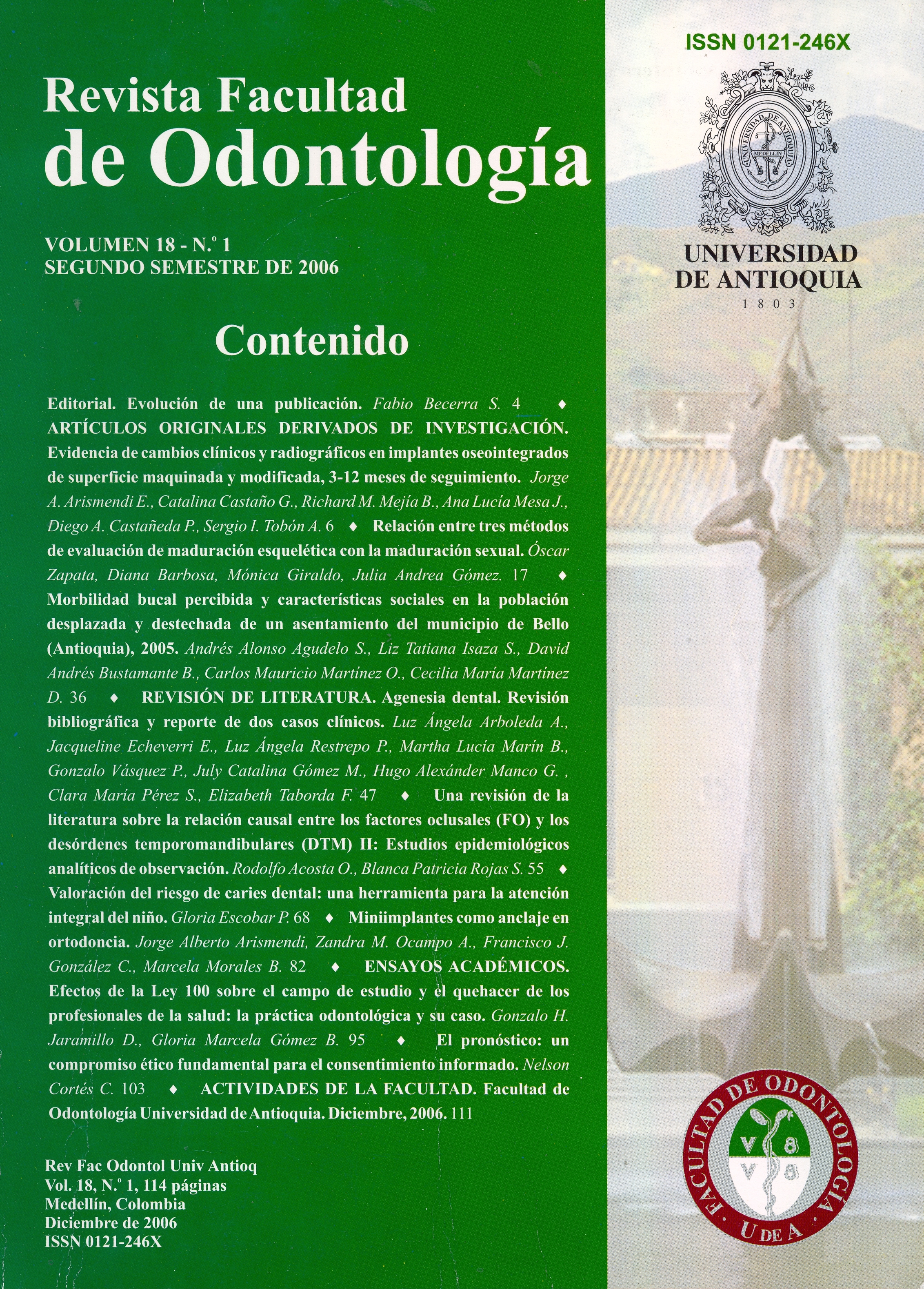Relationship between three methods for the evaluation of skeletal maturation with sexual maturation
DOI:
https://doi.org/10.17533/udea.rfo.2772Keywords:
Puberal growth, Skeletal development, Sexual maturityAbstract
The objective of this study was to determine which of the methods used to establish the skeletal maturation is better related with the maturity of the patient, and for that reason is more practical and applicable to the clinical practice. The relationship between three different methods for evaluating the skeletal maturation through the hand-wrist film (Taranger and Hägg, Greulich and Pyle, and Fishman) and the sexual maturity (Tanner and Prader) was searched. A total of 33 patients were studied: 18 male and 15 female, between 8 and 13 years. Healthy children in Tanner I sexual maturity stage was the research criterion for inclusion. The 100% of both samples (masculine and feminine) were located in the F stage of skeletal development. Data were taken every six months during the course of three years (2000- 2002). In the male population there were no associations between the skeletal maturation evaluated according to Greulich and Pyle´s method, and Fishman´s method with the sexual maturity. On the other hand, an association was found between Taranger and Hägg´s method and the sexual maturity (sesamoid-general Tanner during the fourth sample and the middle phalanx of the third finger- right testicular volume during the same sample, as happened with the middle phalanx with both testicular volumes during de fifth sample). In the female population there were statistically significant associations between Fishman´s method and the sexual maturity during the second and sixth samples; also between Greulich and Pyle´s evaluation and the sexual maturity during the sixth sample. There was also an association between Taranger and Hägg´s method in the second, third and sixth samples (sesamoid-Tanner, middle phalanx-Tanner and sesamoid-Tanner respectively).
Downloads
Downloads
Published
How to Cite
Issue
Section
License
Copyright Notice
Copyright comprises moral and patrimonial rights.
1. Moral rights: are born at the moment of the creation of the work, without the need to register it. They belong to the author in a personal and unrelinquishable manner; also, they are imprescriptible, unalienable and non negotiable. Moral rights are the right to paternity of the work, the right to integrity of the work, the right to maintain the work unedited or to publish it under a pseudonym or anonymously, the right to modify the work, the right to repent and, the right to be mentioned, in accordance with the definitions established in article 40 of Intellectual property bylaws of the Universidad (RECTORAL RESOLUTION 21231 of 2005).
2. Patrimonial rights: they consist of the capacity of financially dispose and benefit from the work trough any mean. Also, the patrimonial rights are relinquishable, attachable, prescriptive, temporary and transmissible, and they are caused with the publication or divulgation of the work. To the effect of publication of articles in the journal Revista de la Facultad de Odontología, it is understood that Universidad de Antioquia is the owner of the patrimonial rights of the contents of the publication.
The content of the publications is the exclusive responsibility of the authors. Neither the printing press, nor the editors, nor the Editorial Board will be responsible for the use of the information contained in the articles.
I, we, the author(s), and through me (us), the Entity for which I, am (are) working, hereby transfer in a total and definitive manner and without any limitation, to the Revista Facultad de Odontología Universidad de Antioquia, the patrimonial rights corresponding to the article presented for physical and digital publication. I also declare that neither this article, nor part of it has been published in another journal.
Open Access Policy
The articles published in our Journal are fully open access, as we consider that providing the public with free access to research contributes to a greater global exchange of knowledge.
Creative Commons License
The Journal offers its content to third parties without any kind of economic compensation or embargo on the articles. Articles are published under the terms of a Creative Commons license, known as Attribution – NonCommercial – Share Alike (BY-NC-SA), which permits use, distribution and reproduction in any medium, provided that the original work is properly cited and that the new productions are licensed under the same conditions.
![]()
This work is licensed under a Creative Commons Attribution-NonCommercial-ShareAlike 4.0 International License.













